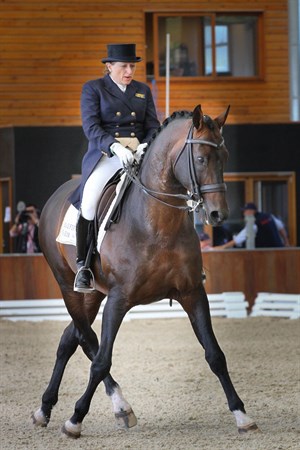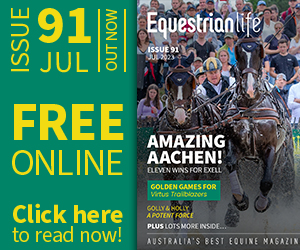|
This article has appeared previously with Equestrian Life. To see what is in our latest digital issue, please click here.

Kerry Mack and Mayfield Pzazz.
© Michelle Terlato
By Kerry Mack
Dressage has been defined as 'the art of riding and training a horse in a manner that develops obedience, flexibility and BALANCE'. I believe that we don't think enough about balance. Improving the balance of the horse is an ABSOLUTELY FUNDAMENTAL goal of training. As he becomes more collected he learns to rock weight back towards the hind legs. His balance becomes more uphill. His centre of gravity moves backwards. As his balance improves he becomes more able to do the work with self carriage and lightness in a way that rhythm is preserved and the other qualities on the training scale improve. Rhythm, suppleness, contact, impulsion, straightness, collection all develop as the horse's balance improves.
Let's take the example of the young horse who has a tendency to be heavy in the hand, leaning on the bit. He may be leaning on the hands to help him balance with the weight of a rider. We all know the difficulty keeping our balance carrying a heavy piggy back rider. The young horse has the same problem. Of course part of the training directed at obedience will help him learn to respond to a light signal, but if we don't help him improve his balance he will still need to balance on the rein.
Some trainers might advocate a stronger bit to discourage him from leaning on it. There is a risk however that this will interfere with the correct contact, and he may drop his back down as he backs off the bit. This of course disengages the hind legs. This is the opposite to what we want to achieve with training.
We need to help him step his hind legs further underneath him. When he does this he will naturally take weight from his front legs and become lighter in the bridle. You cannot force him to balance. You must train him systematically. Transitions between the paces and within the pace are one of the most effective ways to help him balance. Carefully ask him to trot actively forward, then slow him down with half halts. Balance him with the reins, push for a moment and soften the rein (give the rein). You must soften in the down transition so that he learns to slow down in self carriage. As soon as he slows push him forward. This will also help him to learn to maintain self carriage. He learns that if he slows down he must still be prepared to go forward. This can become a bigger transition. Trot briskly, quickly over three steps slow to walk speed, walk but only for three steps, and then trot briskly out. When doing these exercises it is important to get the response you want quickly, so he doesn't just get slow and lazy. You must insist he is in self carriage by making quick transitions and giving the rein, or softening them momentarily
Later on this exercise gets harder as the simple changes are trained. Walk to canter, canter to walk. This is a big test of developing balance, not just obedience. The horse must balance on the hind leg to push cleanly into canter (no trot strides). Then he must canter to walk speed, balancing in these small steps before he walks. When you are training these movements think about the balance. If he pulls against the rein in these transitions it is likely that he is using the rein to help him balance.
Try to think about the balance in all of the work. Whether you are doing transitions, or lateral work, or changes, ask yourself in any exercise 'Is he balanced?'.
If he loses rhythm, or if he lays on your hand (problem with the contact) or if he can't find a way to keep the bend (suppleness) then it is likely that he is losing his balance. This is fundamental. You may need to help him find it again by half halting (balance, push, soft, see previous blog). Or you may help him find his balance by making the steps smaller. Then when he is balanced again ask him to make the steps bigger again.
Notice the ideas and the language I have chosen of him LOSING HIS BALANCE and you HELPING HIM TO FIND IT. This is training at its most interesting; the trainer helping the horse to find something precious.
Have fun,
Kerry Mack.
READ THE LATEST NEWS ARTICLES HERE

|

